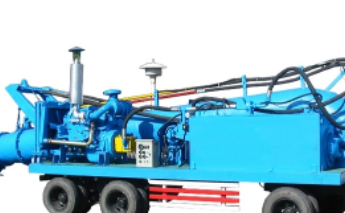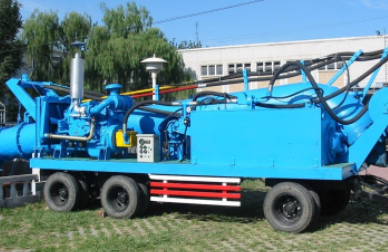What are the considerations in the operation of hydraulic driven submersible pumps
 Dec 31, 2021|
Dec 31, 2021| View:460
View:460The hydraulic driven submersible pumps are the main equipment for water lifting. The whole unit is submerged in water when it is used. It can be used to get groundwater to the surface, which is water for daily life, mine rescue, industrial cooling, farmland irrigation, seawater submersible pump raising, ship transferring, also can be used for fountain scene, hot water submersible pump for hot spring bathing, also can be applied to get groundwater from deep well, also can be used for river, reservoir, aqueduct and other water lifting projects. It is mainly used for farmland irrigation and water for people and animals in high mountains, and also for central air conditioning cooling, heat pump unit, cold pump self-priming pump unit, city, factory, railroad, mine, site drainage. Usually the flow rate can reach (10m3~650m3) per hour and the head can reach 1500m. So, what are the precautions in the use of hydraulic driven submersible pumps?

1、No grounding
hydraulic driven submersible pumps only need to adopt maintenance grounding to ensure personal safety when using. If there is no maintenance grounding, once the shell leakage, the water at the outlet of the submersible pump and pumping water surface charged, endangering the safety of people and animals, while wasting a lot of electricity. If the metal shell of the submersible pump and meet the national standard grounding body (grounding resistance of not more than 4Ω) ground connection, when the submersible pump shell leakage, the current through the submersible pump metal shell, maintenance grounding wire, grounding body, earth, transformer work grounding wire and power supply constitute a closed circuit, when the leakage current is too large, especially when the front touch shell, can make the submersible pump maintenance device action (fuse fuse or Air switch tripping), blocking the power of the submersible pump leakage.
2、No installation of leakage maintainer
hydraulic driven submersible pumps operating in the water, easy to leakage of electricity constitutes a loss of electricity and even cause electric shock accident. If equipped with a leakage protector, as long as the submersible pump leakage value exceeds the leakage protector action current value (usually not more than 30mA), the leakage protector will block the power supply of the submersible pump.
3, power supply voltage anomalies when the power on
The voltage is too high and too low will make the submersible pump temperature rise too high, shorten the service life and even burn the submersible pump. The countryside because of the long low-voltage power supply lines, the end of the line voltage is too low, the beginning of the voltage is too high is a common thing. Therefore, in the process of using the submersible pump, the operator must always investigate the value of the power supply voltage, if it is less than 10% of the additional voltage, more than 10% of the additional voltage, or the current is greater than 20% of the additional current of the submersible pump, should be stopped, and prevent the power supply voltage anomaly when the machine is turned on.
4, motor rotation in the opposite direction
Today there are many types of submersible pumps can be turned and rotary water, but the rotary water output is small, high current, rotary moment will damage the motor windings. Therefore, the submersible pump should be connected to the power supply before entering the water to see if the direction of rotation is accurate. If the three-phase submersible pump impeller reversal, should be immediately shut down, interchange the wiring of any two phases of the three-phase core in the cable can be.
5、Long time overload operation
To prevent the submersible pump overload for a long time, do not use the low head pump for high head operation, do not pump the water with a large amount of sand (heavy mud), and always investigate the current value is not within the rules. If the current is found to be too high, it should be stopped to check. In addition, the submersible pump to water as a cooling source, therefore, the submersible pump dewatering operation should not be too long.
6、Frequent switch
hydraulic driven submersible pumps should not be too frequent start, this is because the submersible pump will stop backflow, if the immediate start, will make the motor load start, resulting in the start of the current is too large. Therefore, after shutdown, we should wait for the end of the water reflux in the tube before starting again, usually requiring an interval of about 5min.

7、Use in silt environment
hydraulic driven submersible pumps in use if sunk in the mud, will lead to poor heat dissipation and burned motor windings. Therefore, the submersible pump must not be used in the mud environment. In order to prevent the submersible pump from sinking into the mud, the submersible pump should be in the water before eradicating its operating environment in the mud, if possible, should also choose to use the gate guard to cover the submersible pump, in order to prevent the waste blocking the water gate, resulting in motor heat, water is not smooth.
8、After being out of use for a long time in the water regardless
If the hydraulic driven submersible pumps are not used continuously after going down the well, they will rust and corrode for a long time, resulting in failure to start. Therefore, the submersible pump should not be placed in the water, should be turned on once a week, running 5 ~ 10min. when not used for a long time, the best not to be immersed in water for a long time, should be placed in clear water to run a few minutes of power, clean the pump surface mud, and then put forward the water surface dry, a big view, disassemble all the parts for maintenance, wipe, rust and scale, replace the wearing parts, and then reassemble the good Then put it in a dry, non-corrosive gas warehouse after painting and rustproofing.



